A Private Tour today, up on the North Norfolk coast. A birthday gift, and a relaxed day of general birding.
After a leisurely start, we headed along the coast road towards Titchwell first. As we drove, a Barn Owl flicked over a hedge near Stiffkey. The other side of Overy Staithe, a Red Kite hung in the air by the road. The first of several of both species we were to see today.
We got to Titchwell and walked out onto the reserve. The weather was much better than the last couple of days, bright but still very breezy. We had some trouble looking out over the Thornham grazing marsh pool, it was so windy, but there was relatively little out there today – a Ringed Plover, a single Ruff and a couple of Redshank. So we headed in the direction of Parrinder Hide to get some shelter.
There were lots of birds out on the freshmarsh. The water levels are now receding slowly, though only a month or more later than expected. The islands are starting to reappear, which at least gives the waders somewhere to go now. Consequently, there was a better selection on here today. There were a handful of Dunlin, several Ringed Plovers and a few Turnstones on the islands. A nice little flock of Ruff in the water, and a separate group of Redshank. And a good number of Avocet.
We spent some time admiring the godwits. There was a little huddle of Bar-tailed Godwits, all mostly still in winter plumage, pushed off the beach by the high tide. Their streaked backs were very different from the plain grey backs of the Black-tailed Godwits nearby, and we could also just see the edges of some barred tails. Some of the Black-tailed Godwits were starting to come into summer plumage, getting orangey about the head and neck, and with some brighter rusty mantle feathers showing.
 Bar-tailed Godwit – a little huddle asleep on the freshmarsh
Bar-tailed Godwit – a little huddle asleep on the freshmarsh
We also had a close look at the wildfowl. A small family group of Brent Geese were on the water close by – we could see how the plain slate grey backs of the two adults differed from the stripier wings of their five young from last year, still with them. A single Shelduck was in amongst the ducks on the freshmarsh as well – though more were out on the Volunteer Marsh.
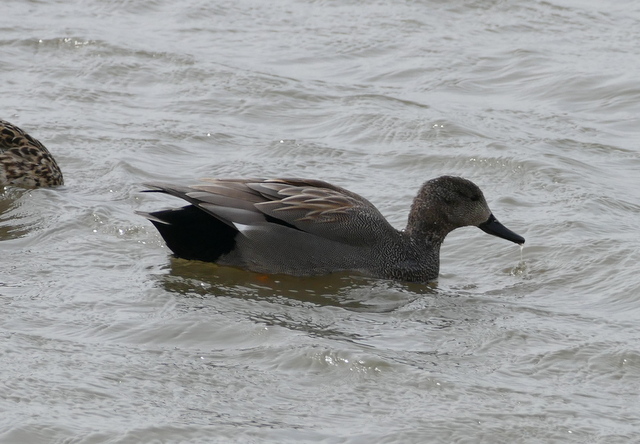 Gadwall – check out the subtle markings of the drakes
Gadwall – check out the subtle markings of the drakes
Gadwall is often dismissed as a rather boring duck but we got a couple of drakes in the scopes and admired their intricate patterning. Drake Teal are more obviously pretty things, and there was a little group of two drakes and two ducks in front of the hide, which broke into a little bout of display. A couple of Wigeon fed on the grassy bank beside the hide. There were lots of Shoveler, many of them already paired up. One particular pair was right below the hide window, feeding feverishly in the choppy waters whipped up by the blustery wind, spinning round with their heads pretty much permanently under the water.
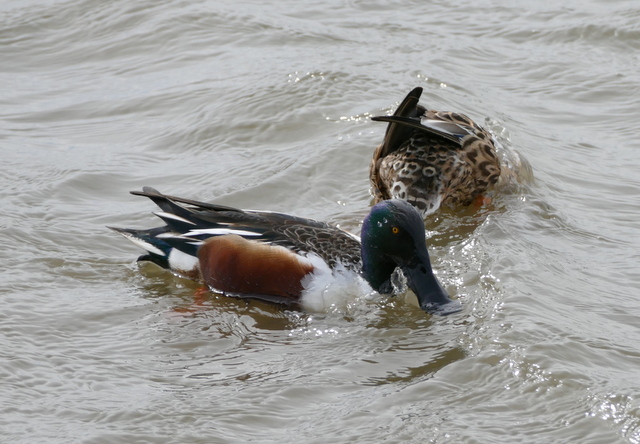 Shoveler – this pair were feeding feverishly
Shoveler – this pair were feeding feverishly
The surprise on the freshmarsh was a single Great Crested Grebe, possibly a refugee from the rough sea. It was diving repeatedly amongst the islands. Later, on our way back, a couple of Little Grebes were by the path as well. The Marsh Harriers were a little subdued today, with no sign of the display much in evidence recently. However, we did see one of the females flying in to the reedbed carrying nest material, so breeding activity has not completely subsided.
The Volunteer Marsh was a little quiet today, perhaps due to the wind whistling across. There were a few Grey Plover, and we watched one feeding out on the mud – standing still, walking a few paces, then bending down to pick at the surface. All this in contrast to the more active feeding of the Redshank next to it, probing into the mud. There were also a couple of Oystercatchers, one with a particularly bright orange bill and the other with its bill covered in sticky black mud. A single Curlew looked rather bright yellowy-brown in the sun. Unusually, there was nothing feeding in the channel by the path today.
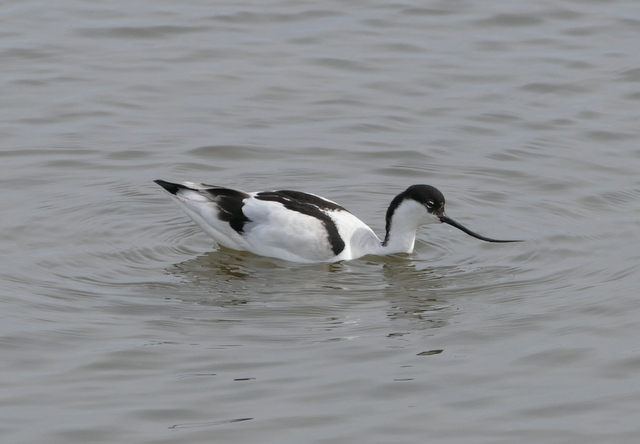 Avocet – a pair were feeding on the tidal pools today
Avocet – a pair were feeding on the tidal pools today
There was a bit more activity on the Tidal Pools. A pair of Avocets fed in the deep water – so deep they looked barely able to stand! There were lots of waders roosting on the islands – more Oystercatchers, Grey Plovers and Bar-tailed Godwits and a few Black-tailed as well. We weren’t going to linger, given the cold wind whistling across, but we could see a couple of ducks further up, right next to the path just before the beach. They stayed put until we got there – a very smart pair of Pintail. The elegant but understated female swam out further from the bank but the drake stayed put and swam round in front of us, showing off its long pin-shaped tail. Eventually, having given us plenty of time to admire them, they flew off back towards the freshmarsh. Stunning.
 Pintail – this stunning drake was right by the path today
Pintail – this stunning drake was right by the path today
Given the conditions, we weren’t planning to try the beach today, but having got this far we decided to have a quick look. The tide was in so there were not many waders on the beach – just a handful of silvery grey Sanderling running in and out of the waves. A small group of Red-breasted Merganser was being tossed about on the sea.
We had other things we wanted to do in the afternoon, so we headed back towards the visitor centre. We stopped on the way to look at a rather scraggly Chinese Water Deer which had stopped to drink in one of the channels out on Thornham saltmarsh. Back in the car park at lunchtime, a Bullfinch called from the trees.
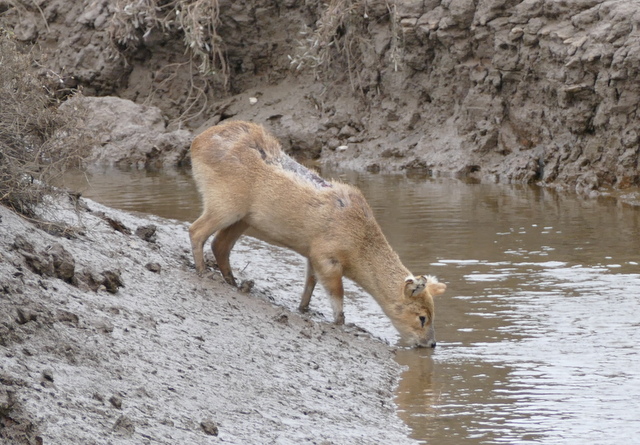 Chinese Water Deer – this rather tatty individual was still on the saltmarsh
Chinese Water Deer – this rather tatty individual was still on the saltmarsh
After lunch, we drove back along the coast road to Holkham. As we parked on Lady Anne’s Drive, a pair of Mediterranean Gulls flew over calling, and flashing their pure white wingtips. We walked west along the path on the inland side of the pines, stopping to admire a couple of little tit flocks – mixed groups of Long-tailed Tits, Blue Tits, Coal Tits and Goldcrests. A Chiffchaff called from the undergrowth along a ditch out of the wind and further on another one sang from the bushes. A pair of Common Buzzards, chased each other around low over the grazing marshes and in front of the edge of the pines.
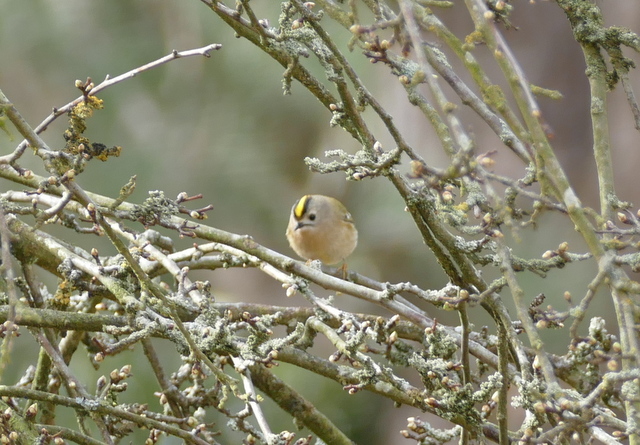 Goldcrest – the smallest British bird, forever on the move
Goldcrest – the smallest British bird, forever on the move
Up in the Joe Jordan hide, a Little Egret was the only white bird on view when we arrived. But after only a short wait, another couple of white birds flew out from the trees with their necks held outstretched – Spoonbills. They dropped onto a little pool nearby and started feeding together, their heads sweeping from side to side with their bills in the water. One was noticeably larger than the other – presumably a pair. After a few minutes, one of them pulled up a stick from the water and set off with it back towards the trees, with the other following behind immediately after. A little later, a third Spoonbill flew in from the east – presumably it had been feeding on the marshes over that way.
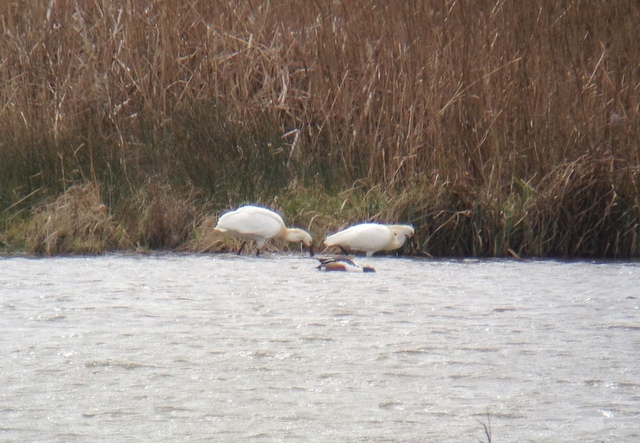 Spoonbill – this pair dropped into a pool for a few minutes
Spoonbill – this pair dropped into a pool for a few minutes
There were lots of other things to look at from the hide as well. We scanned through the geese out on the grazing marshes. Amongst all the Greylag were a few Canada Geese and Egyptian Geese and with them four much smaller Barnacle Geese, presumably also feral birds from the increasing UK population. Still, they looked very smart – black neck sock, white face, pale flanks and black-barred grey back. It took a bit of searching, but eventually we found a small group of five Pink-footed Geese feeding on their own. Most of the thousands which spent the winter here departed last month, but a handful are still lingering – a small number may even stay through the year.
We also saw plenty of raptors. Lots of Marsh Harriers, included one individual sporting green wing tags – unfortunately we couldn’t read them. A couple of Red Kites drifted lazily overhead. A female Kestrel hung in the air in front of the hide for a while – remarkable, given the way the wind was still gusting across.
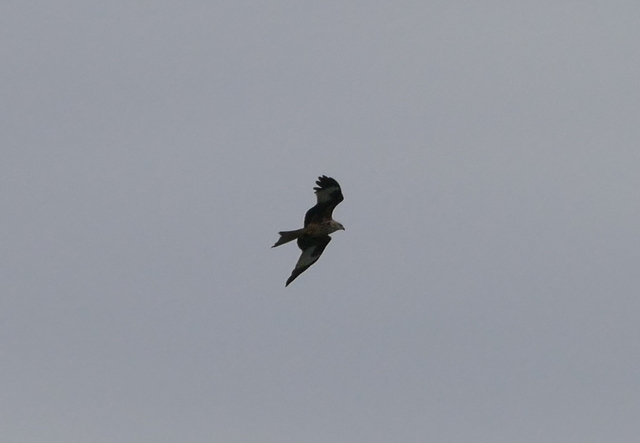 Red Kite – two were over the grazing marsh this afternoon
Red Kite – two were over the grazing marsh this afternoon
After the hide, we wandered the short distance along to the edge of the dunes. A Barn Owl flew across from behind us and out over the grass. We watched it disappear over towards the Burnham Overy seawall, before a second Barn Owl appeared from the same direction. Unfortunately, we were running short of time by now, so we didn’t really have enough time to look for the Rough-legged Buzzard today and there was no sign of it on a quick scan.
We headed back to towards the car and as we arrived back at Lady Anne’s Drive, another Barn Owl appeared over the fields. We saw it quartering, and it hovered before dropping down into the grass. Then yet another appeared, and we paused a while to watch the two Barn Owls hunting over the fields to finish the day.

















